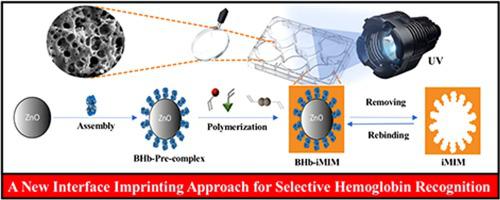Colloids and Surfaces B: Biointerfaces ( IF 5.8 ) Pub Date : 2020-10-25 , DOI: 10.1016/j.colsurfb.2020.111435 Canan Armutcu 1 , Erdoğan Özgür 2 , M Emin Çorman 3 , Lokman Uzun 1

|
In this study, we introduced a new strategy to design interface imprinted polymers for a novel aspect of molecular imprinting technique, utilization of sacrificial metal oxide particles. In the first step, bovine hemoglobin (BHb) was adsorbed on zinc oxide (ZnO) particles, which were then used to synthesize polyacrylic acid-based molecular imprinting membrane by bulk polymerization in the presence of ethylene glycol dimethacrylate as a cross-linking agent. After polymerization terminated, BHb-ZnO particles were removed to leave effective imprint sites onto the bulk polymeric network which is responsible for the formation of template orientation. The characterization of membranes was investigated by using Fourier transform infrared (FTIR), Raman spectroscopy (RS), scanning electron microscopy (SEM), surface area measurements (BET analyses) and thermogravimetric analysis (TGA). The interface molecularly imprinted membranes (iMIMs) have a relatively high specific rebinding capacity of 65.98 mg/g and excellent selectivity towards BHb with a separation factor of 6.78. The equilibrium adsorption isotherms fitted well to Langmuir isotherms (R2 = 0.9944) and the value of adsorption capability (Qmax) and equilibrium constant (b) were estimated to be 73.53 mg/g and 1.36 mg/mL for the iMIM, respectively. The kinetics of adsorption fitted best to pseudo-second order (R2 = 0.9912). The ZnO particles were used not only to ensure the preservation of the imprint cavities in the polymer network but also to lead to high template removal and better rebinding kinetics. This novel design with multiple recognition sites is quite simple and suitable for the separation of biomacromolecules.
中文翻译:

界面印迹聚合物具有良好定向的识别位点,可选择性纯化血红蛋白
在这项研究中,我们介绍了一种设计界面印迹聚合物的新策略,用于分子印迹技术的一个新方面,即利用牺牲金属氧化物颗粒。第一步,将牛血红蛋白(BHb)吸附在氧化锌(ZnO)颗粒上,然后在乙二醇二甲基丙烯酸酯作为交联剂的存在下,通过本体聚合将其用于合成聚丙烯酸类分子印迹膜。聚合终止后,将BHb-ZnO颗粒去除,以将有效的压印位点保留在本体模板网络上,这负责形成模板方向。使用傅里叶变换红外(FTIR),拉曼光谱(RS),扫描电子显微镜(SEM)对膜进行了表征 表面积测量(BET分析)和热重分析(TGA)。界面分子印迹膜(iMIM)具有相对较高的比重结合能力65.98 mg / g和对BHb的优异选择性,分离系数为6.78。平衡吸附等温线非常适合Langmuir等温线(R2 = 0.9944),iMIM的吸附能力值(Q max)和平衡常数(b)分别估计为73.53 mg / g和1.36 mg / mL。吸附动力学最适合拟二阶(R 2 = 0.9912)。ZnO颗粒不仅用于确保保留聚合物网络中的压印腔,而且可导致较高的模板去除率和更好的重新结合动力学。这种具有多个识别位点的新颖设计非常简单,适用于生物大分子的分离。



























 京公网安备 11010802027423号
京公网安备 11010802027423号